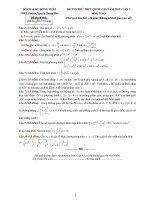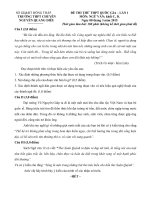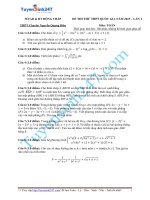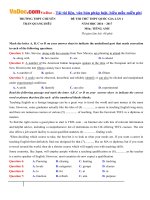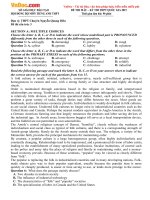Tải Đề thi thử THPT Quốc gia môn tiếng Anh năm 2018 lần 4 trường THPT Chuyên Nguyễn Quang Diệu, Đồng Tháp có đáp án - Đề ôn thi Đại học môn tiếng Anh
Bạn đang xem bản rút gọn của tài liệu. Xem và tải ngay bản đầy đủ của tài liệu tại đây (141.36 KB, 7 trang )
<span class='text_page_counter'>(1)</span><div class='page_container' data-page=1>
<b>TRƯỜNG THPT </b>
<b>CHUYÊN NGUYỄN </b>
<b>QUANG DIỆU</b>
(Đề thi gồm 06 trang)
<b>ĐỀ THI THỬ THPT QUỐC GIA LẦN 4 - 2018</b>
Môn thi: TIẾNG ANH
<i>Thời gian: 60 phút (không kể thời gian phát </i>
<i>đề) Ngày thi: 09/06/2018</i>
<b>Họ, tên thí sinh:...</b>
<b>Số báo danh:...</b>
<i><b>Mark the letter A, B, C, or D on your answer sheet to indicate the word whose </b></i>
<i><b>underlined part differs from the other three in pronunciation in each of the following </b></i>
<i><b>questions.</b></i>
<i><b>Question 1: A. require B. decide C. admit D. provide</b></i>
<i><b>Question 2: A. genders</b></i> <i><b> B. follows</b></i> <i><b>C. humans</b></i> <i><b>D. attracts</b></i>
<i><b>Mark the letter A, B, C, or D on your answer sheet to show the underlined part that </b></i>
<i><b>needs correction.</b></i>
<b>Question 3: It was on May 7</b>th<sub>, 1945 the day that the Second World War ended in Europe.</sub>
<b>A</b> <b>B</b> <b>C</b> <b>D</b>
<b>Question 4: The package containing books and records were delivered last week.</b>
<b>A</b> <b>B</b> <b>C</b> <b>D</b>
<b>Question 5: A baby learns the meanings of words as they are spoken by others and</b>
<b>A</b> <b>B</b> <b>C</b>
later uses him in sentences.
<b>D</b>
<i><b>Mark the letter A, B, C or D on your answer sheet to indicate the word or phrase that is </b></i>
<i><b>CLOSEST in meaning </b><b>to the underlined part in each of the following questions.</b></i>
<b>Question 6: Within a week on display at the exhibition, the painting was praised as a </b>
<b>masterpiece.</b>
<b>A. an excellent work of art</b> <b>B. a down-to-earth work of art</b>
<b>C. an expensive work of art</b> <b>D. a large work of art</b>
<b>Question 7: Computers and telecommunication are bound to have a huge influence on </b>
<b>various</b>
aspects of our life.
<b>A. similar</b> <b>B. like C. diverse D. equivalent</b>
<i><b>Mark the letter A, B, C, or D on your answer sheet to indicate the sentence that is closest </b></i>
<i><b>in meaning to the sentence given in each of the following questions.</b></i>
<b>Question 8: The baby slept soundly even with the noise the children made.</b>
<b>A. The baby woke up because the children made sounds.</b>
<b>B. The baby and the children slept through the noise.</b>
<b>C. The children couldn’t sleep because of the noise.</b>
<b>D. The noise the children made didn’t prevent the baby from sleeping.</b>
<b>Question 9: She started working as a teacher of English ten years ago.</b>
</div>
<span class='text_page_counter'>(2)</span><div class='page_container' data-page=2>
<b>Question 10: My friend told me, "If I were you, I would not cut class so often."</b>
<b>A. My friend prohibited me from cutting class so often.</b>
<b>B. My friend warned me against cutting class so often.</b>
<b>C. My friend suggested not cutting class so often.</b>
<b>D. My friend advised me not to cut class so often.</b>
<i><b>Read the following passage and mark the letter A, B, C, or D on your answer sheet to</b></i>
<i><b>indicate the correct answer to each of the questions.</b></i>
Plants and animals will find it difficult to escape from or adjust to the effects of global
warming. Scientists have already observed shifts in the lifecycles of many plants and
animals, such as flowers blooming earlier and birds hatching earlier in the spring. Many
species have begun shifting where they live or their annual migration patterns due to
warmer temperatures.
With further warming, animals will tend to migrate toward the poles and up mountainsides
toward higher elevations. Plants will also attempt to shift their ranges, seeking new areas
as old habitats grow too warm. In many places, however, human development will prevent
these shifts. Species that find cities or farmland blocking their way north or south may
<b>become extinct. Species living in unique ecosystems, such as those found in polar and</b>
mountaintop regions, are especially at risk because migration to new habitats is not
possible. For example, polar bears and marine mammals in the Arctic are already
<b>threatened by dwindling sea ice but have nowhere farther north to go.</b>
Projecting species extinction due to global warming is extremely difficult. Some scientists
have estimated that 20 to 50 percent of species could be committed to extinction with 2 to
3 Celsius degrees of further warming. The rate of warming, not just the magnitude, is
extremely important for plants and animals. Some species and even entire ecosystems, such
as certain types of forest, may not be able to adjust quickly enough and may disappear.
Ocean ecosystems, especially fragile ones like coral reefs, will also be affected by global
warming. Warmer ocean temperatures can cause coral to “bleach”, a state which if
prolonged will lead to the death of the coral. Scientists estimate that even 1 Celsius degree
of additional warming could lead to widespread bleaching and death of coral reefs around
the world. Also, increasing carbon dioxide in the atmosphere enters the ocean and
increases the acidity of ocean waters. This acidification further stresses ocean ecosystems.
<b>Question 11: Scientists have observed that warmer temperatures in the spring </b>
cause flowers to .
<b>A. become lighter</b> <b>B. bloom earlier</b> <b>C. lose color</b> <b>D. </b>
<b>die instantly Question 12: </b> According to paragraph 2, when their habitats grow
warmer, animals tend to move _.
<b>A. toward the North Pole and down mountainsides toward lower elevations</b>
<b>B. toward the poles and up mountainsides toward higher elevations</b>
<b>C. north-westwards and up mountainsides toward higher elevations</b>
<b>D. south-eastwards and down mountainsides toward lower elevations</b>
<b>Question 13: The pronoun “those” in paragraph 2 refers to .</b>
<b>A. ecosystems</b> <b>B. areas</b> <b>C. species</b> <b>D. habitats</b>
<b>Question 14: The phrase “dwindling sea ice” in paragraph 2 refers to .</b>
<b>A. the violent Arctic Ocean</b> <b>B. the frozen water in the Arctic</b>
<b>C. the cold ice in the Arctic</b> <b>D. the melting ice in the Arctic</b>
<b>Question 15: It is mentioned in the passage that if the global temperature rose by 2 or 3</b>
Celsius degrees, .
</div>
<span class='text_page_counter'>(3)</span><div class='page_container' data-page=3>
<b>B. water supply would decrease by 50 percent</b>
<b>C. the sea level would rise by 20 centimeters</b>
<b>D. half of the earth’s surface would be flooded</b>
<b>Question 16: The bleaching of coral reefs as mentioned in paragraph 4 indicates.</b>
<b>A. the slow death of coral reefs</b> <b>B. the quick growth of marine </b>
mammals
<b>C. the water absorption of coral reefs</b> <b>D. the blooming phase of sea weeds</b>
<b>Question 17: What does the passage mainly discuss?</b>
<b>A. Global warming and species migration</b>
<b>B. Influence of climate changes on human lifestyles</b>
<b>C. Global warming and possible solutions</b>
<b>D. Effects of global warming on animals and plants</b>
<i><b>Read the following passage and mark the letter A, B, C, or D on your answer sheet to</b></i>
<i><b>indicate the correct answer to each of the questions.</b></i>
During the seventeenth and eighteenth centuries, almost nothing was written about the
contributions of women during the colonial period and the early history of the newly
formed United States. Lacking the right to vote and absent from the seats of power, women
were not considered an important force in history. Anne Bradstreet wrote some significant
<i><b>poetry in the seventeenth century, Mercy Otis Warren produced the best contemporary</b></i>
history of the American Revolution, and Abigail Adams penned important letters showing
she exercised great political influence over her husband, John, the second President of the
United States. But little or no notice was taken of these contributions. During these
centuries, women remained invisible in history books.
Throughout the nineteenth century, this lack of visibility continued, despite the efforts of
female authors writing about women. These writers, like most of their male counterparts,
<i><b>were amateur historians. Their writings were celebratory in nature, and they were uncritical</b></i>
in their selection and use of sources.
During the nineteenth century, however, certain feminists showed a keen sense of history
by keeping records of activities in which women were engaged. National, regional, and
local women's organizations compiled accounts of their doings. Personal correspondence,
newspaper clippings, and souvenirs were saved and stored. These sources from the core of
the two greatest collections of women's history in the United States one at the Elizabeth
and Arthur Schlesinger Library at Radcliffe College, and the other the Sophia Smith
Collection at Smith College. Such sources have provided valuable materials for later
Generations of historians.
Despite the gathering of more information about ordinary women during the nineteenth
century, most of the writing about women conformed to the "great women" theory of
history, just as much of mainstream American history concentrated on "great men." To
demonstrate that women were making significant contributions to American life, female
authors singled out women leaders and wrote biographies, or else important women
produced their autobiographies. Most of these leaders were involved in public life as
reformers, activists working for women's right to vote, or authors, and were not
<i><b>representative at all of the great of ordinary woman. The lives of ordinary people</b></i>
continued, generally, to be untold in the American histories being published.
<b>Question 18: What does the passage mainly discuss?</b>
</div>
<span class='text_page_counter'>(4)</span><div class='page_container' data-page=4>
<b>C. The keen sense of history shown by American women</b>
<b>D. The place of American women in written histories</b>
<b>Question 19: In the first paragraph, Bradstreet, Warren, and Adams are </b>
mentioned to show that .
<b>A. a woman's status was changed by marriage</b>
<b>B. only three women were able to get their writing published</b>
<b>C. even the contributions of outstanding women were ignored</b>
<b>D. poetry produced by women was more readily accepted than other writing by </b>
women
<b>Question 20: The word “contemporary” in paragraph 1 means that the history as .</b>
<b>A. written at that time B. informative</b> <b>C. thoughtful</b> <b>D. </b>
faultfinding
<b>Question 21: The word “they” in the second paragraph refers to _ .</b>
<b>A. source</b> <b>B. efforts</b> <b>C. counterparts</b> <b>D. authors</b>
<b>Question 22: According to the passage, which of the following would most likely have </b>
been collected by nineteen-century feminist organizations?
<b>A. Biographies of John Adams and other American presidents</b>
<b>B. Newspaper accounts of presidential election results</b>
<b>C. Books about famous graduates of the country’s first college</b>
<b>D. Letters from a mother to a daughter about how to handle a family </b>
<b>problem Question 23: What use was made of the nineteenth-century women's </b>
history materials in the Schlesinger Library and the Sophia Smith Collection?
<b>A. They provided valuable information for twentieth- century historical researchers.</b>
<b>B. They were combined and published in a multivolume encyclopedia.</b>
<b>C. They formed the basis of college courses in the nineteenth century.</b>
<b>D. They were shared among women's colleges throughout the United States.</b>
<b>Question 24: In the last paragraph, the author mentions all of the following as </b>
possible roles of nineteenth- century "great women" EXCEPT_ .
<b>A. reformers</b> <b>B. activists for women's rights</b>
<b>C. authors</b> <b>D. politicians</b>
<b>Question 25: The word “representative” in the last paragraph is closest in meaning to </b>
_.
<b>A. typical</b> <b>B. satisfied</b> <b>C. distinctive</b> <b>D. </b>
supportive
<i><b>Mark the letter A, B, C or D on your answer sheet to indicate the correct answer to each </b></i>
<i><b>of the following questions.</b></i>
<b>Question 26: He found a watch when he _ </b> in the street.
<b>A. walked</b> <b>B. had been walking</b> <b>C. was walking</b> <b>D. had </b>
walked
<b>Question 27: They live on a busy road </b> a lot of noise from traffic.
<b>A. It must be</b> <b>B. It must have been</b> <b>C. There must have</b> <b>D. There </b>
must be
<b>Question 28: I can't think of any possible </b> for his absence.
<b>A. exploration</b> <b>B. expedition</b> <b>C. expectation</b> <b>D. </b>
explanation
<b>Question 29: It is high time Tom </b> more active in class.
<b>A. is</b> <b>B. has been</b> <b>C. must be</b> <b>D. was</b>
</div>
<span class='text_page_counter'>(5)</span><div class='page_container' data-page=5>
<b>A. to travelling</b> <b>B. travelling</b> <b>C. to travel</b> <b>D. being </b>
travelled
<b>Question 31: The local clubs are _ </b> every effort to interest more young people.
<b>A. making</b> <b>B. giving</b> <b>C. doing</b> <b>D. taking</b>
<b>Question 32: The author had qualified as a doctor but later he gave up the </b> of
medicine for full- time writing.
<b>A. procedure</b> <b>B. prescription</b> <b>C. practice</b> <b>D. treatment</b>
<b>Question 33: Mrs. Smith, _ </b> has a lot of teaching experience, is going to join our
school in September.
<b>A. who</b> <b>B. whose</b> <b>C. whom</b> <b>D. that</b>
<b>Question 34: A(n) </b> was parked opposite my house.
<b>A. new Italian shiny sports car</b> <b>B. Italian new shiny sports car</b>
<b>C. shiny new Italian sports car</b> <b>D. Italian shiny new sports car</b>
<b>Question 35: What are the entry _ </b> at this university?
<b>A. required</b> <b>B. requirements</b> <b>C. requirement</b> <b>D. require</b>
<b>Question 36: Don't smoke in the forest. Fires </b> easily at this time of the year.
<b>A. turn on</b> <b>B. break out</b> <b>C. put out</b> <b>D. carry on</b>
<b>Question 37: Could you please </b> _ an appointment for me to see Mr. Smith?
<b>A. take</b> <b>B. arrange</b> <b>C. manage</b> <b>D. have</b>
<i><b>Mark the letter A, B, C, or D on your answer sheet to indicate the most suitable response </b></i>
<i><b>to complete each of the following exchanges.</b></i>
<b>Question 38: Two friends Diana and Anne are talking about endangered species in the </b>
world today.
- Diana: “I read somewhere recently that about 137 species of animals and plants become
extinct every day.”
- Anne: “ ”
<b>A. Well, maybe all is not lost yet.</b> <b>B. What’s point?</b>
<b>C. It can’t have happened like that.</b> <b>D. What a pity!</b>
<b>Question 39: Mary is talking to her professor in his office.</b>
- Mary: “Can you tell me how to find material for my science report, professor?”
- Professor: “ _”
<b>A. Try your best, Mary!</b> <b>B. I like it that you understand.</b>
<b>C. You mean the podcasts from other students? D. You can borrow books from the </b>
library.
<i><b>Mark the letter A, B, C, or D on your answer sheet to indicate the sentence that best </b></i>
<i><b>joins each of the following pairs of sentences in each of the following questions.</b></i>
<b>Question 40: My father encouraged me in my choice of career. That’s why I become a chef</b>
now.
<b>A. Hadn’t my father encouraged me in my choice of career, I would become a chef</b>
now.
<b>B. If my father hadn’t been courageous, I would never have become a chef now.</b>
<b>C. If it had not been for my father’s encouragement, I wouldn’t become a chef now.</b>
<b>D. It was my father who encouraged me to become a chef otherwise I had chosen</b>
another career.
<b>Question 41: The basketball team knew they lost the match. They soon started to blame</b>
each other.
<b>A. Hardly had the basketball team known they lost the match when they started to</b>
blame each other.
</div>
<span class='text_page_counter'>(6)</span><div class='page_container' data-page=6>
other as well.
<b>C. As soon as they blamed each other, the basketball team knew they lost the match.</b>
<b>D. No sooner had the basketball team started to blame each other than they knew </b>
they lost the match.
<i><b>Read the following passage and mark the letter A, B, C, or D on your answer sheet to </b></i>
<i><b>indicate the correct word or phrase that best fits each of the numbered blanks.</b></i>
Many students in the UK consider doing a gap year before going to university. Critics
question whether it is a just a long glorified holiday or if it's really (42)_ doing. Does it
actually help students in their careers? Some educational establishments do encourage
students to take a gap year and recommend that students take advantage of the
opportunities available. (43) , most of them would prefer it if the students did some kind
of voluntary work instead of just having a holiday. There are numerous organisations
which organise these (44) _ for students and it's a good idea to check them out online.
One of the main advantages is that it's a great way to get to know more about different
cultures and, for many, it is also a painless way to learn another language by speaking to
local people. Volunteers who stay in local homes say that they get the chance to experience
local culture and customs and, in (45) , to try a variety of food which they wouldn't
otherwise have tried. When I was 18 years old, I had set my heart on going to work in
Africa for a year, but unfortunately my parents wouldn’t (46)_ me go and insisted that I
went to university immediately. I'm 49 years old and still haven’t had my gap year! Maybe
one day I'll get around to doing it.
<b>Question 42: A. benefit</b> <b>B. worth</b> <b>C. value</b> <b>D. afford</b>
<b>Question 43: A. Though</b> <b>B. However</b> <b>C. In addition</b> <b>D. Therefore</b>
<b>Question 44: A. travels</b> <b>B. trips</b> <b>C. voyages</b> <b>D. journeys</b>
<b>Question 45: A. specific</b> <b>B. individual</b> <b>C. particular</b> <b>D. common</b>
<b>Question 46: A. agree</b> <b>B. allow</b> <b>C. let</b> <b>D. permit</b>
<i><b>Mark the letter A, B, C, or D on your answer sheet to indicate the word that differs from </b></i>
<i><b>the other three in the position of the primary stress in each of the following questions.</b></i>
<b>Question 47: A. indifferent B. sympathetic</b> <b>C. emotional</b> <b>D. responsible</b>
<b>Question 48: A. guarantee B. individual</b> <b>C. secondary</b> <b>D. university</b>
<i><b>Mark the letter A, B, C, or D on your answer sheet to indicate the word(s) OPPOSITE </b></i>
<i><b>in meaning to the underlined word(s) in each of the following questions.</b></i>
<b>Question 49: We couldn’t roller-skate or skateboard on the road because it was too rough.</b>
<b>A. cold</b> <b>B. bumpy</b> <b>C. smooth</b> <b>D. far</b>
<b>Question 50: If you are at a loose end this weekend, I will show you round the city.</b>
<b>A. occupied</b> <b>B. free</b> <b>C. confident</b> <b>D. reluctant</b>
</div>
<span class='text_page_counter'>(7)</span><div class='page_container' data-page=7>
TRƯỜNG THPT
CHUYÊN NGUYỄN
QUANG DIÊU
<b></b>
<b>---ĐỀ THI THỬ THPT</b>
<b>QUỐC GIA NĂM 2018</b>
<b>– LẦN 4 Môn: TIẾNG ANH</b>
<i>Thời gian làm bài 60 phút, không kể thời gian giao</i>
<i>đề.</i>
———————
<b>Mã đề thi 524</b>
Họ, tên thí sinh:...Số báo danh ...
<b>Câu</b> <b>Đáp án</b> <b>Câu</b> <b>Đáp án</b> <b>Câu</b> <b>Đáp án</b> <b>Câu</b> <b>Đáp án</b> <b>Câu</b> <b>Đáp án</b>
1 <b>C</b> 11 <b>B</b> 21 <b>D</b> 31 <b>A</b> 41 <b>A</b>
2 <b>D</b> 12 <b>B</b> 22 <b>D</b> 32 <b>C</b> 42 <b>B</b>
3 <b>B</b> 13 <b>C</b> 23 <b>A</b> 33 <b>A</b> 43 <b>B</b>
4 <b>C</b> 14 <b>D</b> 24 <b>D</b> 34 <b>C</b> 44 <b>B</b>
5 <b>D</b> 15 <b>A</b> 25 <b>A</b> 35 <b>B</b> 45 <b>C</b>
6 <b>A</b> 16 <b>A</b> 26 <b>C</b> 36 <b>B</b> 46 <b>C</b>
7 <b>C</b> 17 <b>D</b> 27 <b>D</b> 37 <b>B</b> 47 <b>B</b>
8 <b>D</b> 18 <b>D</b> 28 <b>D</b> 38 <b>A</b> 48 <b>C</b>
9 <b>A</b> 19 <b>C</b> 29 <b>D</b> 39 <b>D</b> 49 <b>C</b>
10 <b>D</b> 20 <b>A</b> 30 <b>B</b> 40 <b>C</b> 50 <b>A</b>
</div>
<!--links-->

